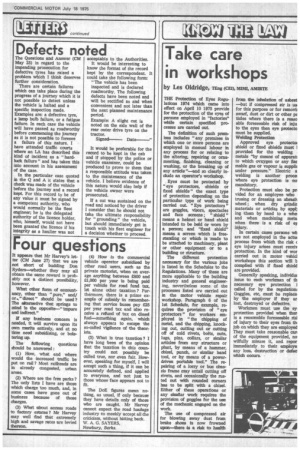Take care in workshops
Page 31

If you've noticed an error in this article please click here to report it so we can fix it.
by Les Oldridge, TEng (CE!), MIMI, AMITE THE Protection of Eyes Regulation's 1974 which came into effect on April 10 1975 provide for the protection of the eyes of persons employed in "factories" while certain specified processes are carried out The definition of such promises includes "any premises in which one or more persons are employed in manual labour in any process for or relating to the altering, repairing or ornamenting, finishing, cleaning or washing, or the breaking up of any article "--and so clearly include an operator's workshop.
Eyes must be protected by "eye protectors, shields or fixed shields" the exact type of protection depending on the particular type of work being curried out. "Eye protectors" are goggles, visors, spectacles and face screens ; "shield" means a helmet or hand shield Intended to he held or worn by a person; and "fixed shield" means a screen which is freestanding or which is 'made to be attached to machinery, plant or other equipment or to a building or structure.
The different protection necessary for the various jobs is listed in the Schedules to the Regulations. Many of these are more applicable to the building industry and general engineering, nevertheless some of the processes listed are carried out in the motor vehicle repair workshop. Paragraph 6 of the let Schedule, for example, requires the provision of "eye protectors" for workers employed in "the chipping of metal, and the chiming, knocking out, cutting out or cutting off of cold rivets, bolts, nuts, lugs, pins, collars, or similar articles from any structure or plant, by means of a hammer, chisel, punch, or similar hand tool, or by means of a powerdriven portable tool." The repairing of a lorry or bus chassis frame may entail cutting off rivets, and occasionally the rusted nut with rounded corners has to be .spflit with a chisel. Either of these operations or any similar work requires the provision of goeeles for the use of the mechanic engaged on the work.
The use of compressed air for blowing away dust from brake shoes is now frowned upon—there is a risk to health from the inhalation of asbest —but if compressed air is us for this purpose or for removii swart, duet or dirt or other pa tides where there is a reaso able foreseeable risk of inju to the eyes then eye protect° must be supplied.
Welding Protection Approved eye protectoi shield or fixed shields must 1 provided for the welding metals "by meane of appazati to which ovxygen or any flax mable gas or vapour is supplk under pressure." Electric a welding 'is another. proem -where eye protection is no mandatory.
Protection must also be pr vided for an employee who trueing or dressing an abrash wheel; when dry grindic materials or articles by appt lag them by hand to a whe and when machining meta when there is a risk of ey injury.
In certain cases person's wh are not employed in the actin process from which the risk c eye injury arises must receiv protection. In the kind of wor carried out in motor vehicl workshops this section will b complied with if fixed shield are provided.
Generally speaking, individur issue to each workman of th necessary eye protection i called for by the mgulation: Gaggles, etc, must be replace by the employer if they ar lost, destroyed or defective.
Workmen must use the ey protection provided when then is a reasonable foreseeable risl of injury to their eyes from tie job on which they are employed They must take reasonable can of the equipment provided, no wilfully misuse it, and repor immediately to their employe any loss. destruction or delete which occurs. •




























































































